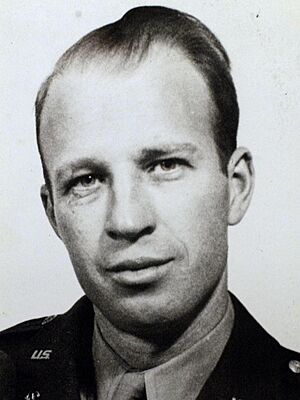Frank Olson facts for kids
Quick facts for kids
Frank Rudolph Olson
|
|
|---|---|
 |
|
| Born | July 17, 1910 Hurley, Wisconsin, United States
|
| Died | November 28, 1953 (aged 43) |
| Occupation | Bacteriologist, bioweaponeer |
| Years active | 1943–1953 |
| Spouse(s) | Alice Smith "Wicks" Olson |
| Children | 3 |
Frank Rudolph Emmanuel Olson (July 17, 1910 – November 28, 1953) was an American bacteriologist, biological warfare scientist, and an employee of the United States Army Biological Warfare Laboratories (USBWL) who worked at Camp Detrick (now Fort Detrick) in Maryland.
Biography
Youth and education
Olson was born to Swedish immigrant parents in Hurley, Iron County, Wisconsin. Olson graduated from Hurley High School in 1927. Olson enrolled at the University of Wisconsin, earning both a B.S. and, in 1938, a Ph.D. in bacteriology. He married his classmate, Alice, and would go on to have three children. Olson enrolled in the Reserve Officers' Training Corps to help pay off his college costs, and was called to active duty at Fort Hood in Texas as the United States entered World War II. Olson worked for a short time at Purdue University's Agricultural Experimentation Station before being called to active duty.
Work with the Army & CIA
Olson served as a captain in the U.S. Army Chemical Corps. In December 1942, he got a call from Ira Baldwin, his thesis adviser at UW and the future mentor of Sidney Gottlieb, who would go on to be the CIA's leading chemist and director of MK-ULTRA. Ira had been called to leave his University post to direct a secret program regarding the development of biological weapons, and wanted Olson to join him as one of the first scientists at what would become Fort Detrick. The army transferred him to Edgewood Arsenal in Maryland. A few months later, the Chemical Corps took over Detrick and established its secret Biologicals Warfare Laboratories.
At Camp Detrick, Baldwin worked with industrial partners such as George W. Merck and the U.S. military to establish the top secret U.S. bioweapons program beginning in 1943, during World War II, a time when interest in applying modern technology to warfare was high. Olson also worked with ex-Nazis who had been brought into the country through Operation Paperclip on the utilization of aerosolized anthrax.
Olson was discharged from the Army in 1944 and remained at Detrick on a civilian contract, continuing his research into aerobiology. In 1949, he joined many other Detrick scientists in Antigua for Operation Harness, which tested the vulnerability of different animals to toxic clouds. In 1950, he was a part of Operation Sea-Spray, where the bacterium Serratia marcescens was released into the coastal mists of San Francisco through a minesweeper, reaching all of San Francisco's 800,000 residents, as well as people living in eight surrounding cities. Olson traveled often to Fort Terry, a secret army base off Long Island, where toxins too deadly to be brought onto the U.S. mainland were tested.
This was the period where senior military officials and CIA officers were becoming deeply troubled at Soviet progress, and feared they were heading towards mastery of microbe warfare. Their alarm led to the forming of the Special Operations Division at Detrick in spring of 1949, with the purpose of conducting research on covert ways to utilize chemical weapons. SOD was known as a "Detrick within a Detrick" due to its level of secrecy. Olson became acting chief of SOD within a year of its creation, originally invited to join by colleague and SOD's first chief, John Schwab.
At some point while assigned as a civilian U.S. Army contractor, Olson began working as a CIA employee. In May 1952, Frank Olson was appointed to the committee for Project Artichoke, an experimental CIA interrogation program.
Disaffection
By the time Olson stepped down as chief of SOD in early 1953, citing "pressures of the job" that aggravated his ulcers, he had officially joined the CIA after working closely with them for years. He did stay with SOD, which functioned as a CIA research station hidden within a military base. Olson did a lot of work at Detrick that his children said had a lasting effect on his psyche.
On February 23, 1953, the Chinese broadcast charges that two captured American pilots had claimed the U.S. was conducting germ warfare against North Korea. Other captured Americans such as Colonel Walker "Bud" Mahurin made similar statements. The United States government threatened to charge some POWs with treason for cooperating with their captors. After their release, the prisoners of war would publicly repudiate their confessions as having been extracted by torture. On 27 July 1953, the Korean Armistice Agreement was signed, launching Operation Big Switch, the repatriation of Korean War POWs. Twenty-one American POWs refused repatriation and defected, and the returning POWs were viewed as potential security risks. As a result, debriefings became "hostile investigations in search of possible disloyalty". The day the armistice was signed, Olson, a bacteriologist, arrived in Northolt, UK. Olson's home movies from the trip indicate he traveled to London, Paris, Stockholm, and Berlin. Upon his return, Olson's mood was noticeably changed, according to his family. According to coworker Norman Cournoyer, Olson had witnessed interrogations in Europe and become convinced that the United States had used biological weapons during the Korean War. Journalist Gordon Thomas claims that Olson subsequently visited William Sargant, a British psychiatrist with high level security clearances. According to Thomas, Sargant reported that Olson had become a security threat and his access to military facilities should be limited.
Olson had spent a decade at Detrick and knew all the secrets of the Special Operations Division. He frequently traveled to Germany to witness interrogation sessions in multiple secret prisons (evidence places Olson in Frankfurt, Berlin, and Heidelberg), where the victims would occasionally die.

